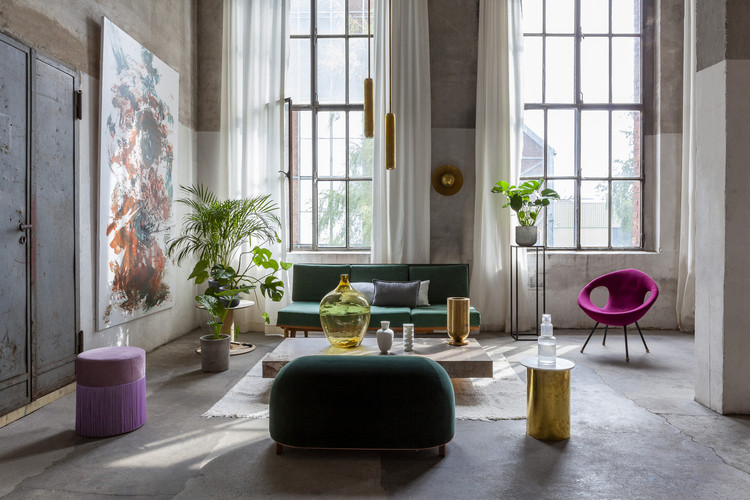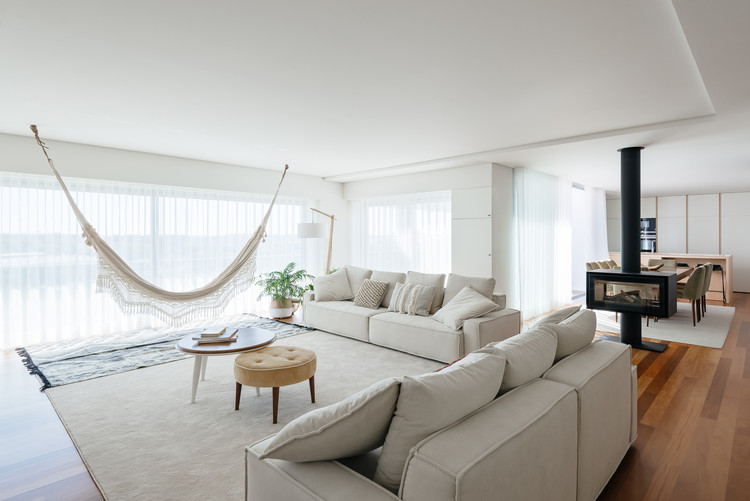
Today, architecture has become - or is in the process of becoming - more flexible and individualistic to accommodate people's diverse lifestyles and spatial needs. With this adaptation, the residential typology has changed and living rooms have become endangered. Many insist on the need of having a space dedicated to relaxation and leisure, while others claim it is simply a waste of space and money. This debate raised an important question: do we still need living/sitting rooms? In this interior focus, we will look at how living rooms evolved through the years, and how architects readapted and integrated the concept of “gathering space” in contemporary residential architecture.
Although they share the same purpose - a place to gather - many countries differentiate between living rooms and family rooms. Living rooms are considered more formal and elevated, whereas family rooms are a more casual place to hang out and spend time with family members. Oftentimes, living rooms are placed at the entrance, or near the entrance, whereas family rooms are closer to the bedrooms and other private spaces. In terms of interior design and décor, living rooms are where house owners show off their artwork and unique furniture pieces, unlike the family room, which is more casual and comfortable. In this article, both living and family rooms will be explored as one gathering space.

The world was first introduced to living rooms in the late 17th century, when France’s Louis XV found his predecessor’s lifestyle at the Versailles extremely uncomfortable, as it had only formal salons and not a single room dedicated for relaxation. The king, who was known for his interest in furniture and décor, transformed a couple of rooms in the chateau into private living rooms, inaugurating the concept of combining formal and informal living. Fast forward a couple of decades later, the world of architecture and interior design across the world began creating signature furniture pieces dedicated to these private spaces, and shortly after the industrial revolution, comfort stood at the forefront. Right after the Second World War, Americans were heavily invested in family rooms, embodying the image of casual suburban family life with a television, sofas, and entertainment. It became evident that the living room has become the heart of a modern home. Today, however, the heart of a modern home has shape-shifted into a big open space that combines both the kitchen and sitting room or disappeared entirely.

In a recent editorial by The Guardian’s Elle Hunt, the editor claims that millennials have in fact “killed” the need of having a living room because they simply don’t need them anymore. This is a result of several lifestyle and cultural changes observed among millennials. While some refrain from having large families, others don’t have the financial means to purchase large houses that include a dedicated gathering space. Several types of research have highlighted how millennials are spending more but earning less, compared to the workforce of the 80s and 90s; “almost two-fifths now renting privately at age 30 and spending nearly a quarter of their net income on housing”. In other words, small houses are all they could afford. On another note, one of the many reasons why living rooms are no longer needed is the fact that in some areas, newly-built studios (approx. 40 sqm) have staggering high prices and restrictions on land use, which forces interior architects to remove non-essential spaces, and an area dedicated to just sitting is most likely the “first to go”.

The concept of “gathering space” has been readapted from one generation to another, and from one culture to another. This comes as a response to the constant changes in lifestyles, habits, cultural norms, and financial stability. Most people now focus on convenience and functionality instead of formality. Theoretically, living rooms were created as a private spaces to relax and socialize. Today’s workforce is all about networking, spending most of their time online or out-and-about building connections, which is why they feel that having a living room dedicated to relaxation only does not suit their busy schedule; the bedroom would suffice. As for socializing, if outdoor restaurants, bars, or other public spaces are inaccessible, their house's kitchen or balcony would be the ideal substitute.
Read on to discover how architects reimagined traditional living rooms and readapted them to fit different contemporary residential typologies.
Private Room
The traditional living room has transcended generations and cultures and maintained its presence in modern-day residential projects. Whether it's an apartment or a private house, projects with large spatial areas allow architects to dedicate a room for the sole purpose of gathering or relaxing. These spaces are either designed with bespoke furniture and accessories to host guests or formal events or transformed into a secluded and comfortable escape for the family members. Larger houses tend to have both, each catering to its respective function.
Chaptal Residence / Nathalie Eldan Architecture

Ewelina Art Studio / Ewelina Makosa

A Moulting Flat / Husos Architects

PH-13 Apartment / Atelier L'inconnu

Open-Floor Plan
Over the past few decades, a big amount of residents began opting for open living room/kitchen areas where everything flows together. Many interior designers credit allocating the living room next to the kitchen to food, since cooking is known as one of the most successful means of bringing people together, and people find it easier to circulate around the space and host guests. It is also important to keep in mind that open-floor plans were a result of "design individualism", where residents purchase or rent their houses as a blank canvas that they can design and organize the way they please without any permanent work.
Patio Apartment / RAS·A

Colours of My Life Apartment / WY-TO architects

Bukit Merah Apartment / MONOCOT

Sabará Apartment / Felipe Rodrigues Arquitetura

Extended Platforms
Houses with private landscapes allow architects to extend their ground floor, creating a transitional space between the interior and exterior that serves as both a formal and informal gathering area. This type of living room is often surrounded by the kitchen, garden, and/or swimming pool, making it an ideal spot to host guests and relax with family members. Similarly, patios and front porches are also considered extended platforms used for relaxation and leisure.
House in Santo Tirso / Hous3

A6 House / gruta.arquitetos

Light House / Studio Guilherme Torres

Forest House / Rogoski Arquitetura

Terraces and Balconies
Other transitional spaces that residents use as gathering spaces are terraces and balconies. Architects take advantage of the plot they have and create an additional outdoor space that visually integrates architecture and nature, and serves as a secluded retreat that overlooks the surrounding landscape.
Stiff Peaks / Byben & Skeens

Escandón Terrace / PALMA

Fitzroy Terrace House / Taylor Knights

House STA / Dietrich | Untertrifaller Architekten
AIS.jpg?1632899401)
Sources:
- The Invention of the Family Room
- The evolution of the modern living room
- Don't worry, we millennials don't need living rooms anyway
Find more projects of living rooms in this My ArchDaily folder created by the author.
This article is part of an ArchDaily series that explores features of interior architecture, from our own database of projects. Every month, we will highlight how architects and designers are utilizing new elements, new characteristics, and new signatures in interior spaces around the world. As always, at ArchDaily, we highly appreciate the input of our readers. If you think we should mention specific ideas, please submit your suggestions.

This article is part of the ArchDaily Topics: The Contemporary Home, proudly presented by BUILDNER.
BUILDNER celebrates architecture competitions as an effective tool for achieving progress by fostering groundbreaking ideas that push the industry forward. “Through academic and project competitions, we are building an inclusive and diverse community of architects and designers, by promoting critical topics such as affordable, sustainable, and small-scale housing to address global challenges. Our goal is to inspire the next generation of designers to propose innovative solutions and challenge the status quo.”
Every month we explore a topic in-depth through articles, interviews, news, and architecture projects. We invite you to learn more about our ArchDaily Topics. And, as always, at ArchDaily we welcome the contributions of our readers; if you want to submit an article or project, contact us.





















AIS.jpg?1632899401)





